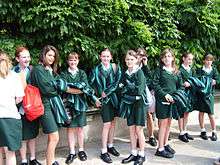School uniforms in England


_with_Classmates_at_Abbotsholme_School%2C_Rocester%2C_Uttoxeter%2C_Staffordshire%2C_England%2C_UK.jpg)
School uniforms in England had become quite common by the 16th century. Some schools had uniforms called "blue coats", as they consisted of long trench-coat-style jackets dyed blue. Blue was the cheapest available dye and encouraged humility amongst the schoolchildren. The first school to introduce this uniform was Christ's Hospital and it is the oldest uniform of any school.[1]
In 1870, the Elementary Education Act 1870 made elementary education available for all children in England and Wales. The popularity of uniforms increased, and eventually most schools had a uniform.[2] Most uniforms reflected the trends of the age, with boys wearing short trousers and blazers until roughly the age of puberty and then long trousers from about 14 or 15. Girls mainly wore blouses, tunic dresses and pinafores later progressing towards the beginning of the 20th century to gymslips,[2][3] worn together with a blouse.[4]
These uniforms continued until the 1950s, when after the Butler reforms secondary education was made free and the school leaving age was raised to 15. These reforms encouraged schools to implement uniform codes which were similar to other schools. Distinct "summer" and "winter" uniforms were sometimes required, particularly for girls, for whom dresses were mandated for summer and gymslip for winter.[2]
Today, the Government believes that school uniforms play a valuable role in contributing to the ethos of schools: The Department for Children, Schools and Families strongly encourages schools to have a uniform, as it can instil pride; support positive behaviour and discipline; encourage identity with, and support for, the school ethos; ensure pupils of all races and backgrounds feel welcome; protect children from social pressures to dress in a particular way; nurture cohesion and promote good relations between different groups of pupils.[5]
School uniforms are required to be fair for both genders, be available at a reasonably low cost and tolerate religious freedoms e.g. allowing Sikhs to wear turbans.[6]
See also
References
- ↑ "Bluecoat Schools". Boys School Uniform. Archived from the original on July 23, 2008. Retrieved 28 August 2008.
- 1 2 3 "The History of School Uniforms". Historical Boys Clothing. Retrieved 28 August 2008.
- ↑ "Victorian Girl's School Uniform". Object lessons. Archived from the original on April 27, 2006. Retrieved 28 August 2008.
- ↑ "School uniforms in the UK". Album 1900. Retrieved 3 September 2016.
- ↑ DCSF guidance to schools on school uniform and related policies teachernet.gov.uk, accessed 16 January 2010
- ↑ "School uniform", CBBC Newsround, retrieved on 28 August 2008.